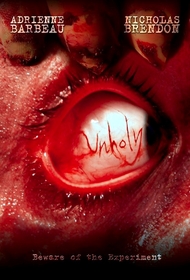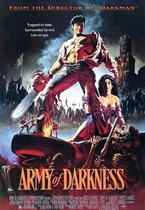Our editor-in-chief Nate Yapp is proud to have contributed to the new book Hidden Horror: A Celebration of 101 Underrated and Overlooked Fright Flicks, edited by Aaron Christensen. Another contributors include Anthony Timpone, B.J. Colangelo, Dave Alexander, Classic-Horror.com's own Robert C. Ring and John W. Bowen. Pick up a copy today from Amazon.com!
Unholy (2007)
For a film that is only 82-minutes long, Unholy has too much plot. It dabbles in the occult, government conspiracies, brainwashing, suicide, time travel, and Nazism but doesn’t have enough time to explain how these pieces fit into the grander scheme of the movie’s ever-running puzzle, likely because there is no answer. For a movie with so much happening, it’s also slow-moving, uninteresting, and dull. It contains a few formulaic scenes that are fright-inducing, and then repeats them over and over again until they become cringe-inducing. There is some decent acting to be found, at least as decent as the material will allow; the dialogue doesn’t stir the audience’s interest and not even the characters can seem to follow the plot.
Martha (Adrienne Barbeau, The Fog, Escape From New York), upon witnessing the suicide of her daughter Hope (Siri Baruc, The Ten) in the cellar of their home, calls her slacker, pot-smoking son Lucas (Nicholas Brendon, “Buffy the Vampire Slayer”) home to help her investigate Hope’s untimely death. Their investigation leads to the discovery of a cassette tape that, looking back in retrospect, I wish hadn’t been found in the first place, because perhaps then the movie would have continued to make sense. The contents of the tape perpetuate the plot beyond coherence, introducing the idea that a local town legend thought to have been dead for centuries might have been using Hope to conduct top-secret mind control experiments using techniques developed by the Nazis during the Second World War. Gertrude (Susan Willis), the estranged wife of Martha’s neighbor Charlie (Merwin Goldsmith, “Law and Order”), predicted such an occurrence before and no one listened.
All the while, Martha and Lucas are running around town, picking up clues and trying to make sense of it all. There is a scene toward the end of the film where the characters are explaining the plot while sitting in a car, panting and heaving their last breaths, and I could relate with their exhaustion just attempting to recall the details myself. It is not enough that the dialogue of the film has the characters telling the audience what is happening; the dialogue needs to explain much more than it tells. Instead of lines that would help diagnose the plot, we’re given glib remarks like, “hope is lost,” which explains nothing and makes me seriously question the use of Hope as a name for one of the characters. Now I’m left to wonder which came first, that line or the character’s name.
Lost in the crowded plot and unhelpful dialogue is the acting, which is a bright spot for the film, though sometimes overdramatizing veers its ugly head. As the perpetually frightened and confused Martha, Barbeau delivers a solid performance and oversells the material with heavily dramatized shrieks of terror. Brendon holds his own with Barbeau and demonstrates a wide range of emotions. Most other characters work simply to provide interactions for the two main leads, but Goldsmith’s Charlie character has a kind of forced-friendliness to him, as if Goldsmith wants to be the villain but has the friendly neighbor role instead.
Behind the camera, first-time director Daryl Goldberg uses his limited set pieces and low budget to his advantage, but reverts too much to the same formula. Most of the film’s scares are provided with images, such as the scene in the cellar when Martha and Lucas unveil Hope’s paintings of Nazi soldiers dressed in full regime. Goldberg will occasionally revert to the formulaic scare, however, where something will suddenly appear on-screen accompanied by a loud noise. He repeats this formula a lot during Martha’s constant dream sequences; the first time it’s frightening, but then it loses its edge the numerous times after that it is repeated. Goldberg also uses the film’s soundtrack, primarily a piano score, to set the mood and tone of his piece. Though a noble effort, it becomes a problem when the film’s pace slows; the tempo of the music follows suit and the effect is almost a lullaby for the audience.
Unholy is not to be faulted for its low-budget, production designs, or set pieces, or even its acting and directing, but for a plot that isn’t worth following. Far too much happens for a town as small as the one in film. Running around attempting to make sense of it all isn’t just part of the plot, it is also part of the experience of watching the film itself. It is a film that requires multiple viewings, but due to the slow-pace and generally dull nature, Unholy isn’t likely to get that much-needed second glance.








